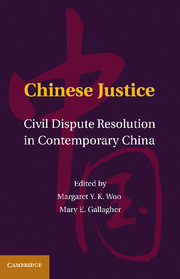Book contents
- Frontmatter
- Contents
- Tables and Figures
- Contributors
- Acknowledgments
- Abbreviations
- Glossary
- Introduction
- PART I LEGAL DEVELOPMENT AND INSTITUTIONAL TENSIONS
- PART II PU FA AND THE DISSEMINATION OF LAW IN THE CHINESE CONTEXT
- 5 The Impact of Nationalist and Maoist Legacies on Popular Trust in Legal Institutions
- 6 Public Attitudes toward Official Justice in Beijing and Rural China
- 7 Users and Non-Users: Legal Experience and Its Effect on Legal Consciousness
- 8 With or without the Law: The Changing Meaning of Ordinary Legal Work in China, 1979–2003
- PART III LAW FROM THE BOTTOM UP
- Conclusion: Chinese Justice from the Bottom Up
- Index
- References
6 - Public Attitudes toward Official Justice in Beijing and Rural China
Published online by Cambridge University Press: 05 July 2011
- Frontmatter
- Contents
- Tables and Figures
- Contributors
- Acknowledgments
- Abbreviations
- Glossary
- Introduction
- PART I LEGAL DEVELOPMENT AND INSTITUTIONAL TENSIONS
- PART II PU FA AND THE DISSEMINATION OF LAW IN THE CHINESE CONTEXT
- 5 The Impact of Nationalist and Maoist Legacies on Popular Trust in Legal Institutions
- 6 Public Attitudes toward Official Justice in Beijing and Rural China
- 7 Users and Non-Users: Legal Experience and Its Effect on Legal Consciousness
- 8 With or without the Law: The Changing Meaning of Ordinary Legal Work in China, 1979–2003
- PART III LAW FROM THE BOTTOM UP
- Conclusion: Chinese Justice from the Bottom Up
- Index
- References
Summary
Gruesome media accounts from both China and abroad on the performance of Chinese legal institutions, perhaps best exemplified by the Pulitzer Prize–winning series on “ragged justice,” are consistent with scholarly reports of pervasive travesties of justice in the court system and abuses of power in the police system. Notwithstanding this conventional story of endemic failures in China's legal system, survey evidence tells the opposite story: highly positive popular perceptions of – and an overwhelming popular willingness to mobilize – both the courts and the police. Which of these two seemingly contradictory stories is correct? In this chapter, we use survey data from Beijing and rural China on popular perceptions of official justice and on firsthand assessments of encounters with official justice to argue that the story of upbeat perceptions and the story of downbeat encounters paradoxically are both correct.
Our analysis is divided into two steps. First, we analyze general perceptions of the performance of the legal system. Here we consider public attitudes toward, popular confidence in, and popular support for official justice – defined in this chapter as the courts and the police. Second, we analyze personal assessments of direct encounters with official justice. Whereas the first analytical step encompasses all individuals regardless of whether or not they reported prior experience in the legal system, the second is limited to aggrieved individuals who brought their grievances to some part of the legal system.
- Type
- Chapter
- Information
- Chinese JusticeCivil Dispute Resolution in Contemporary China, pp. 169 - 203Publisher: Cambridge University PressPrint publication year: 2011
References
- 37
- Cited by

